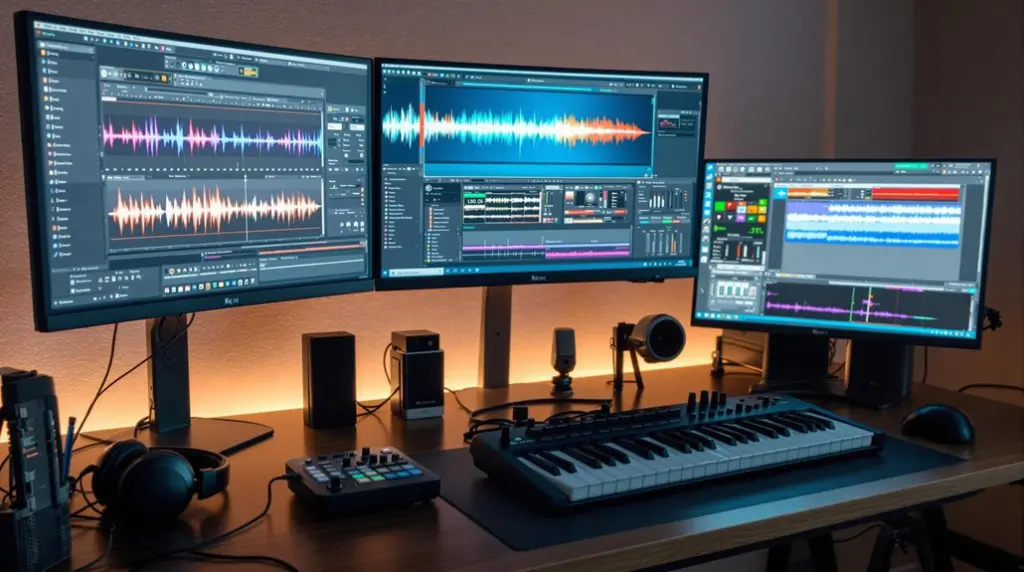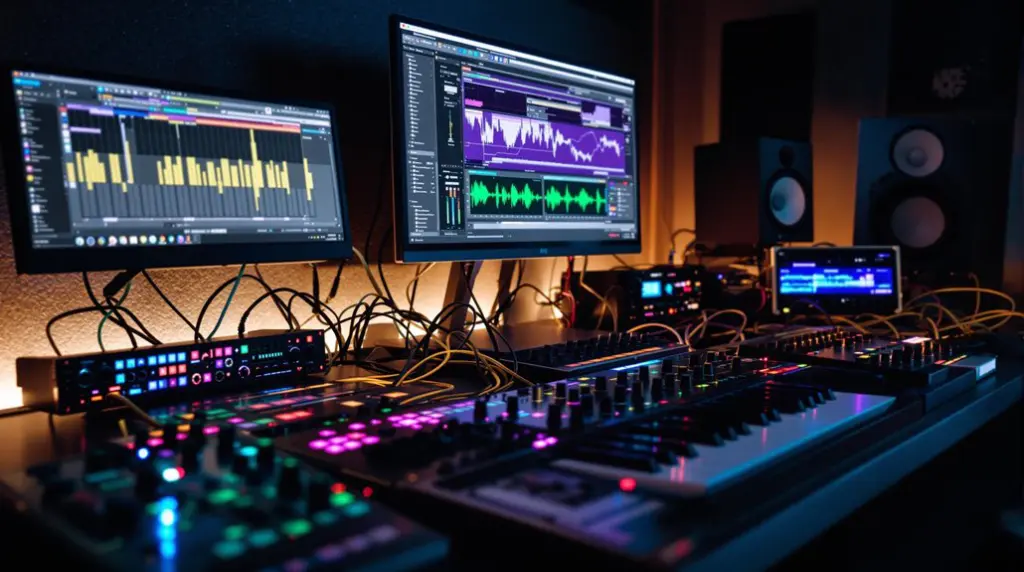The Behringer DeepMind 12 boasts a robust 12-voice analog polyphonic structure and dual DCOs per voice, making it a versatile tool for rich sound design. It features extensive modulation possibilities and a thorough effect section with 34 DSP effects, but its menu-heavy interface can hinder workflow efficiency. Build quality is solid with durable materials, though the absence of an FX bypass button detracts from usability. Connectivity options are varied, including MIDI, USB, and Wi-Fi, ensuring seamless integration with modern setups. Despite these minor drawbacks, its competitive pricing and feature set make it an attractive option for both novices and seasoned musicians seeking more insights on its capabilities.
Key Takeaways
- The Behringer DeepMind 12 offers a rich analog sound with 12-voice polyphony and dual oscillators per voice.
- Extensive modulation options are supported by a robust Mod Matrix with 22 sources and nearly 130 destinations.
- The durable build with a metal chassis and wooden side panels combines vintage aesthetics with modern reliability.
- Menu navigation can be cumbersome, potentially interrupting workflow and user experience.
- Absence of an FX bypass button may affect those seeking pure analog signal paths.
Product Overview
The Behringer DeepMind 12, a 12-voice analog polyphonic synthesizer, stands out in the market with its combination of robust design and broad functionality, priced competitively at $999.
This instrument is encased in a durable metal chassis with aesthetically pleasing wooden side panels, reflecting both its sturdy construction and vintage-inspired design.
Key synthesizer features include dual oscillators per voice, with Oscillator 1 offering sawtooth and square waves, while Oscillator 2 is dedicated to square waves. This configuration enables a range of classic analog tones.
The 49-note keyboard, sensitive to both velocity and aftertouch, enhances expressive playing. The modulation matrix is particularly remarkable, providing 22 modulation sources and nearly 130 destinations, allowing for complex sound manipulation.
Incorporating 34 DSP-derived effects, modeled after classic units, the DeepMind 12 provides four effect slots for versatile sound shaping. High-quality output guarantees pristine audio fidelity.
Connectivity is thorough, with support for MIDI, USB, and Wi-Fi for rtpMIDI, guaranteeing seamless integration with modern production setups.
Sound Design Capabilities
Building on the robust design and extensive feature set discussed previously, exploring the sound design capabilities of the Behringer DeepMind 12 reveals a highly versatile synthesis engine. The dual-oscillator structure, with Oscillator 1 offering both sawtooth and square waves and Oscillator 2 providing square waves, offers a substantial sound palette for timbral exploration. This configuration allows users to craft diverse and complex timbres.
The inclusion of 1,024 onboard presets and an intricate modulation matrix, which supports routing 22 sources to nearly 130 destinations, further expands the creative potential. The drift parameters add an organic touch, mitigating the sterile nature often attributed to digital synthesis.
| Feature | Description |
|---|---|
| Dual-Oscillator Design | Sawtooth and square waves on Oscillator 1; square waves on 2 |
| Modulation Matrix | 22 modulation sources, 130 destinations |
| Drift Parameters | Adds organic qualities, reduces clinical digital characteristics |
The filter section, offering both 24dB and 12dB/octave modes with self-resonance, facilitates rich and dynamic filtering effects, enhancing the depth of the sound palette. Additionally, the unison modes in the poly section contribute to thick sounds, suitable for lush pads and intricate harmonics. Collectively, these elements make the DeepMind 12 a powerful tool for sound designers seeking a diverse and dynamic range of sonic possibilities.
Effects and Modulation
Among the myriad features of the Behringer DeepMind 12, its effects and modulation capabilities stand out as particularly formidable. The synthesizer includes 34 DSP-derived effects inspired by classic units, offering extensive effect customization for users seeking to enhance their sound palette. These effects range from reverb and delay to chorus and distortion, ensuring a thorough suite of sonic enhancements.
The inclusion of four effect slots, which can be configured for either insert or FX send setups, adds a layer of flexibility in sound design not often found in synthesizers of this price range. Understanding the dynamic range compression techniques can further refine the use of effects, ensuring clarity and consistency in the output.
The modulation flexibility of the DeepMind 12 is another key strength, facilitated by its dedicated Mod Matrix. With 22 modulation sources and nearly 130 destinations, the instrument allows for intricate modulation routing, enabling complex sound shaping and dynamic evolution of tones.
Each voice is equipped with independent envelopes for both the VCA and VCF sections, granting users enhanced control over dynamics and tonal characteristics, essential for nuanced performance.
However, the absence of an FX bypass button is a noted drawback, potentially affecting the overall sonic character when effects cannot be easily disengaged. Despite this, the DeepMind 12’s effects and modulation capabilities remain robust, offering significant creative potential.
Sequencing and Performance
While the DeepMind 12‘s effects and modulation capabilities offer considerable sound design flexibility, its sequencing and performance features further enhance its standing as a versatile synthesizer. Central to this is its robust arpeggiator, which boasts a six-octave range and supports user-editable patterns. This allows for extensive creative sequencing, with modes such as chord mode and adjustable gate length adding to its sequencer flexibility. Proper frequency analysis can also help fine-tune these sequences, ensuring each element stands out clearly in a mix.
The control sequencer is another standout feature, designed for creating 32-step custom modulation sequences. This enables intricate and dynamic sound manipulation, pivotal for both live performance and studio production. The instrument’s healthy voice count of 12 voices facilitates complex sound layering, elevating performance dynamics and ensuring rich, multi-textured outputs.
Additionally, dual LFOs offer seven waveforms with adjustable slew rates, providing extensive modulation capabilities to enhance performance expressiveness. Connectivity options are also well-considered, with MIDI and USB support, complemented by Wi-Fi for rtpMIDI, ensuring seamless integration with other gear and systems.
- Six-octave range arpeggiator with user-editable patterns
- 32-step control sequencer for custom modulation sequences
- 12-voice polyphony for complex sound layering
- Dual LFOs with seven waveforms and adjustable slew rates
- MIDI, USB, and Wi-Fi connectivity for enhanced integration
These features collectively make the DeepMind 12 a powerful tool for both sequencing and performance.
Build Quality
Encased in a robust metal chassis, the Behringer DeepMind 12 exudes durability and sophistication, further accentuated by its aesthetically pleasing wooden side panels. This synthesis of design aesthetics and material durability underscores the instrument’s professional-grade construction.
The heavy-duty metal case not only enhances the visual appeal but also provides substantial protection against the rigors of frequent transport, making it an ideal choice for both studio use and live performances. The early reflections parameter in reverb settings similarly defines the perceived size and character of the audio space.
Weighing in at a manageable level, the DeepMind 12 is designed for portability without compromising its structural integrity. The inclusion of a 49-note velocity and aftertouch-sensitive keyboard adds to the expressive playability, ensuring that the tactile experience matches the instrument’s visual and physical robustness.
High-quality components are meticulously integrated within the compact design, delivering a professional feel that does not consume excessive space on stage or in the studio.
Furthermore, the DeepMind 12’s three-year warranty offers consumers added confidence in its reliability and longevity, reflecting Behringer’s commitment to quality.
User Interface
The user interface of the Behringer DeepMind 12 is centered around a monochrome 128 x 96 display, which some users find to be anachronistic given its 2016 release.
Despite its seemingly outdated screen, the synthesizer provides a functional user experience through its intuitively structured control panel. However, this simplicity comes at the cost of frequent menu exploration, which can be cumbersome for those accustomed to touchscreens or more modern interfaces.
Key features influencing user experience and interface exploration include:
- Monochrome Display: The 128 x 96 resolution screen can feel limited, especially for users expecting more graphical feedback.
- Voice LEDs: These provide critical visual feedback, aiding in performance by indicating simultaneous key presses and tuning discrepancies.
- Compact Control Panel: Featuring a data entry slider and four cursor keys, the design avoids a cramped feel, facilitating easier operation.
- Basic Functions Access: Many basic functions require exploring through on-screen menus, which can interrupt workflow for users preferring a one-knob-per-parameter design.
- Menu Exploration: Although the interface aims for simplicity, the necessity of exploring menus can be challenging, particularly for those more familiar with modern touchscreen interfaces.
Connectivity Options
The Behringer DeepMind 12 excels in connectivity options, featuring extensive MIDI in, out, and thru ports, as well as USB 2.0 for efficient integration with both traditional MIDI hardware and modern computer-based setups.
Additionally, its Wi-Fi capabilities enable wireless MIDI communication through rtpMIDI, enhancing flexibility for live performances and studio environments.
The DeepMind 12 also supports phantom power for condenser mics when connected to an appropriate audio interface, guaranteeing compatibility with a wide range of recording scenarios.
These connectivity features guarantee that the DeepMind 12 can seamlessly integrate into a wide range of audio production workflows.
MIDI and USB
With its robust connectivity options, the Behringer DeepMind 12 guarantees seamless integration into any sophisticated music production setup. Critical to this integration are its MIDI and USB functionalities, enabling the synthesizer to harmonize effortlessly with other equipment and digital audio workstations (DAWs).
The DeepMind 12 is equipped with extensive MIDI integration through MIDI In, Out, and Thru connections, facilitating seamless communication with other MIDI devices for enhanced performance capabilities. This allows for complex MIDI configurations and precise synchronization with external hardware, ensuring peak performance in both studio and live settings.
Equally significant is the USB functionality. The USB 2.0 port allows direct connection to computers, streamlining the process of integrating the synthesizer with DAWs for recording, sound editing, and software-based control. This connectivity guarantees that the DeepMind 12 can be a central component in modern digital production environments.
Key features include:
- MIDI In, Out, and Thru for robust MIDI device integration.
- USB 2.0 for direct computer connections and DAW integration.
- Extensive MIDI control for advanced configurations and synchronization.
- Compatibility with software editors for Windows, OS X, and iOS.
- Facilitates seamless integration into both studio and live setups.
These features collectively underscore the DeepMind 12’s versatility and adaptability within diverse production workflows.
Wi-Fi Capabilities
Building on its extensive MIDI and USB connectivity, the Behringer DeepMind 12 further extends its integration capabilities with robust Wi-Fi support for rtpMIDI. This wireless advantage enables seamless MIDI connectivity with compatible devices, such as computers, tablets, and smartphones. By facilitating enhanced performance and control options, the Wi-Fi capabilities align with the modern demands of music production and live performance environments.
The DeepMind 12’s Wi-Fi support allows users to remotely control and edit parameters via compatible software applications. This setup flexibility greatly simplifies stage arrangements, reducing the reliance on extensive MIDI cabling and contributing to a cleaner, more organized performance space. Additionally, the wireless connectivity enhances the user experience by offering more versatile control modalities, which can be particularly beneficial during live performances and studio sessions.
| Feature | Benefit |
|---|---|
| Wi-Fi for rtpMIDI | Wireless MIDI connectivity |
| Enhanced Integration | Compatibility with various devices |
| Remote Control | Edit via software applications |
| Setup Flexibility | Cleaner stage environment |
| Modern Design | Aligns with contemporary practices |
Market Position
Positioned at a competitive price point of $999, the Behringer DeepMind 12 strategically targets both novice and seasoned musicians within the analog synthesizer market. This pricing places the DeepMind 12 favorably within the competitive landscape, making it an attractive option for a wide target audience.
The synthesizer distinguishes itself with a blend of analog warmth and modern features, including 1,024 onboard presets and extensive modulation capabilities, setting it apart from both its predecessors and its contemporaries.
The DeepMind 12’s market position benefits from several key factors:
- Affordable Price: At $999, the DeepMind 12 offers professional features at a fraction of the cost of high-end analog synthesizers.
- Rich Feature Set: With features inspired by classic models like the Juno-106, it serves as a homage while integrating modern enhancements.
- Broad Appeal: Its design and capabilities cater to both entry-level users and experienced musicians seeking versatility and depth.
- Competitive Edge: By competing directly with established brands such as Roland and Korg, it provides a feature-rich alternative in the market. Additionally, the synthesizer’s in-depth tutorials available through various music production blogs enhance its usability and appeal.
- Positive Reception: Initial favorable reviews and Behringer’s commitment to a dedicated synthesizer division suggest strong market potential.
Pros and Cons
Evaluating the Behringer DeepMind 12 within the competitive landscape highlights its strengths and weaknesses, contributing to a thorough understanding of its market position.
On the positive side, the DeepMind 12 boasts a formidable 12-voice analog polyphonic architecture, each voice equipped with two Digitally Controlled Oscillators (DCOs). This configuration enables a rich and diverse sound palette, which is critical in product comparison for analog synthesizers.
In addition, the extensive modulation capabilities, featuring a dedicated Mod Matrix with 22 modulation sources and nearly 130 destinations, greatly enhance the user experience by offering unparalleled sound design flexibility.
However, the instrument is not without its drawbacks. Some users report that the control panel’s reliance on menus to access basic functions can be cumbersome, especially for those who prefer the immediacy of one-knob-per-parameter designs. This can detract from the overall user experience.
Moreover, the absence of an FX bypass button is another limitation. Although the integrated effects are central to the instrument’s sonic character, the inability to bypass them can compromise the purity of the analog signal path.
Frequently Asked Questions
What Is the Deepmind 12 a Clone Of?
The Behringer DeepMind 12 is not a direct clone of any specific synthesizer. Instead, it employs synthesis techniques and sound design elements inspired by classic models like the Roland Juno series, while integrating modern technology and unique features.
Is Deepmind 12 Analog or Digital?
The Behringer DeepMind 12 is an analog/digital hybrid synthesizer. It combines analog sound design with digital synth features, including digitally controlled oscillators (DCOs) and DSP-derived effects, achieving classic warmth with modern versatility in sound production.
What Is Deepmind a Copy Of?
The Behringer DeepMind 12 is not a direct copy of any specific synthesizer but draws heavily from synthesizer history, particularly the Roland Juno series, while incorporating advanced sound design capabilities through its extensive modulation matrix and digital effects.
What Is the Difference Between Deepmind 6 and 12?
The primary difference between the DeepMind 6 and 12 lies in their features: the DeepMind 12 offers 12 voices and two DCOs per voice, enhancing sound design capabilities, while the DeepMind 6 has 6 voices and fewer modulations.
Conclusion
The Behringer Deepmind 12 synthesizer offers extensive sound design capabilities, a robust suite of effects and modulation options, and versatile sequencing and performance tools. Its build quality and user interface are generally well-regarded, though some limitations exist. Connectivity options are thorough, positioning the instrument competitively within its market segment. Overall, the Deepmind 12 presents a compelling choice for both novice and experienced synthesists, balancing affordability with a rich feature set and technical versatility.




